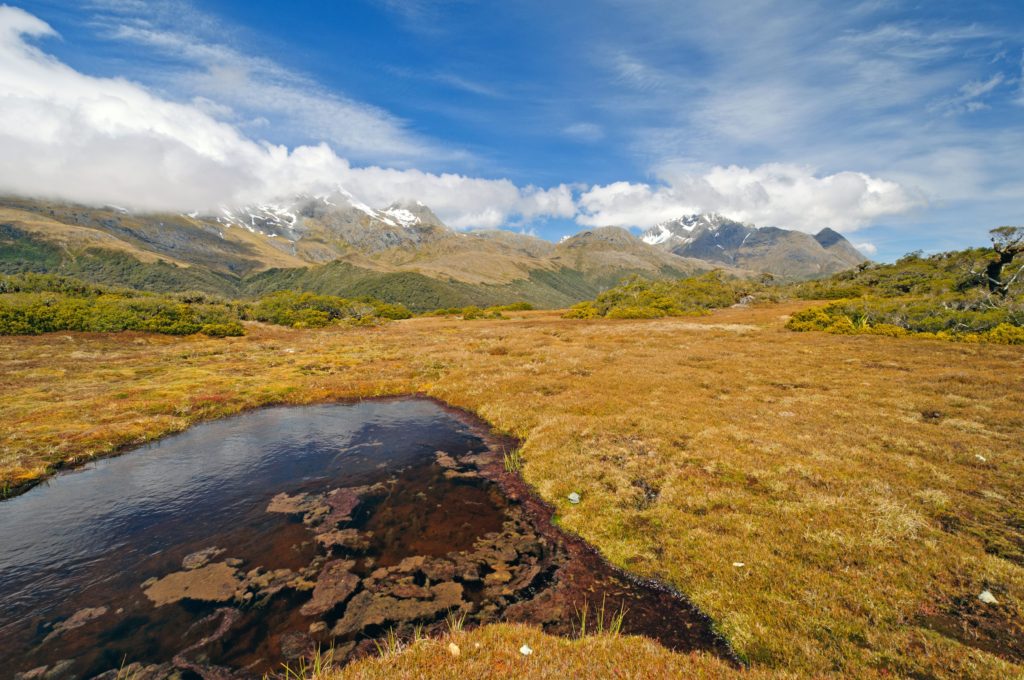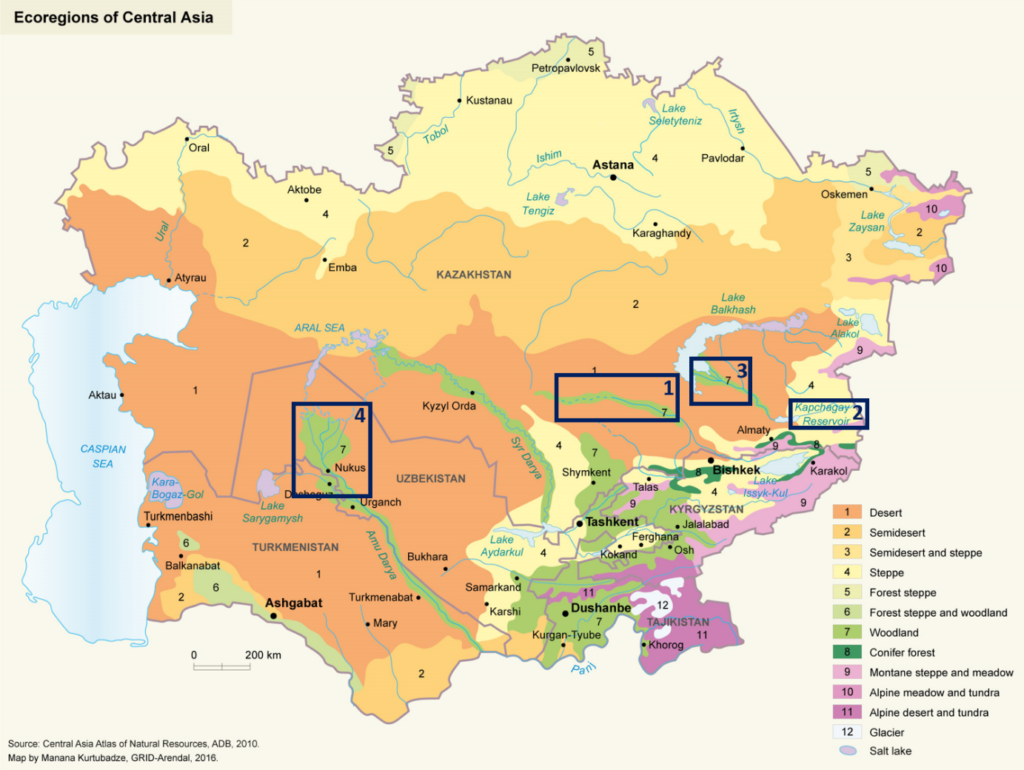Wetland distribution trends in Central Asia
Nora Tesch1*, Niels Thevs2
1 Eberhard Karls Universität Tübingen, Germany
2 World Agroforestry Centre (ICRAF) Central Asia Programme, Kyrgyzstan
*Corresponding author: nora.tesch@mailbox.org
Niels Thevs: n.thevs@cgiar.org
https://doi.org/10.29258/CAJWR/2020-R1.v6-1/39-65.engScientific Article

Abstract
Anthropogenic activities and climate change contribute to the deterioration of wetlands worldwide with Central Asia (CA) being among the regions which are most severely affected. This study examined how the distribution of wetlands in CA has changed in the last two decades. Emphasis was put on inland wetlands protected as International Bird and Biodiversity Areas. Time series of maps of wetlands (i.e. reed beds) were created for the years 2000, 2005, 2010, 2015 and 2018. A supervised classification approach was applied using NDVI of MODIS satellite images with 1000m resolution for the respective years. Ground control points were acquired through fieldtrips to the lower Chu River, upper Ili River and Ili River Delta in Kazakhstan and the Amu Darya River Delta and the Lower Amu Darya State Biosphere Reserve in Uzbekistan. The applied method is not applicable for the classification of wetlands in northern Kazakhstan. The vegetation there is too alike to the wetland vegetation in terms of values and seasonality of NDVI. For the remaining part of the study area, the applied method delivers satisfying results. However, it is difficult to determine a general trend for most wetland areas since there is a large variability between years. This study marks a first attempt at examining wetlands in CA at a regional scale. The results provide a baseline for further, more detailed research through either fieldtrips or by using higher resolution remote sensing data.
Download the articleHow to cite: Tesch, N., & Thevs, N. (2020). Wetland Distribution Trends in Central Asia. Central Asian Journal of Water Research, 6(1), 39–54. https://doi.org/10.29258/cajwr/2020-r1.v6-1/39-65.eng
References
- Adam, E., Mutanga, O. and Rugege, D., 2010. Multispectral and hyperspectral remote sensing for identification and mapping of wetland vegetation: a review. Wetlands Ecology and Management. Vol.18, No 3, pp. 281–296.
- Aizen, V. B., Aizen, E. M. and Kuzmichenok, V. A., 2007. Geo-informational simulation of possible changes in Central Asian water resources. Global and Planetary Change, Vol. 56, No 3-4, pp. 341–358.
- Aralova, D., Toderich, K., Jarihani, B., Gafurov, D. and Gismatulina, L., 2016. Monitoring of vegetation condition using the NDVI/ENSO anomalies in Central Asia and their relationships with ONI (very strong) phases. Proceedings Volume 10005, Earth Resources and Environmental Remote Sensing/GIS Applications VII, 1000512.
- Bai, J., Chen, X., Yang, L. and Fang, H., 2012. Monitoring variations of inland lakes in the arid region of Central Asia. Frontiers of Earth Science, Vol. 6, No 2, pp. 147–156.
- Bekturganov, Z., Tussupova, K., Berndtsson, R., Sharapatova, N., Aryngazin, K. and Zhanasova, M., 2016. Water Related Health Problems in Central Asia—A Review. Water, Vol. 8, No 6, 219.
- BirdLife International, 2019. Important Bird Areas factsheet: Alekseevskie steppe pine forests., viewed 3 January 2019/ Available at: http://datazone.birdlife.org/site/factsheet/alekseevskie-steppe-pine-forests-iba-kazakhstan.
- Davidson, N.C., 2014. How much wetland has the world lost? Long-term and recent trends in global wetland area. Marine and Freshwater Research, Vol. 65, No 10, 934.
- Dwyer, J. and Schmidt, G., 2006. The MODIS Reprojection Tool. In: In: Qu J. J., Gao W., Kafatos M., Murphy R. E., Salomonson V. V. (Eds.), Earth Science Satellite Remote Sensing. Springer, Berlin, Heidelberg, pp. 162–177.
- Fluet-Chouinard, E., Lehner, B., Rebelo, L.-M., Papa, F. and Hamilton, S.K., 2015. Development of a global inundation map at high spatial resolution from topographic downscaling of coarse-scale remote sensing data. Remote Sensing of Environment, Vol. 158, pp. 348–361.
- Huete, A., Didan, K., Miura, T., Rodriguez, E.P., Gao, X. and Ferreira, L.G., 2002. ‘Overview of the radiometric and biophysical performance of the MODIS vegetation indices. Remote Sensing of Environment, Vol. 83, No 1-2, pp. 195–213.
- Imentai, A., Thevs, N., Schmidt, S., Nurtazin, S. and Salmurzauli, R., 2015. Vegetation, fauna, and biodiversity of the Ile Delta and southern Lake Balkhash — A review. Journal of Great Lakes Research, Vol. 41, No 3, pp. 688–696.
- Klein, I., Dietz, A.J., Gessner, U., Galayeva, A., Myrzakhmetov, A. and Kuenzer, C., 2014. Evaluation of seasonal water body extents in Central Asia over the past 27 years derived from medium-resolution remote sensing data. International Journal of Applied Earth Observation and Geoinformation, Vol. 26, pp. 335–349.
- Klein, I., Gessner, U. and Kuenzer, C., 2012. Regional land cover mapping and change detection in Central Asia using MODIS time-series. Applied Geography, Vol. 35, No 1-2, pp. 219–234.
- Kuenzer, C., Klein, I., Ullmann, T., Georgiou, E., Baumhauer, R. and Dech, S., 2015., Remote Sensing of River Delta Inundation: Exploiting the Potential of Coarse Spatial Resolution, Temporally-Dense MODIS Time Series. Remote Sensing, Vol. 7, No 7, pp. 8516–8542.
- Landmann, T., Schramm, M., Colditz, R.R., Dietz, A. and Dech, S., 2010. Wide Area Wetland Mapping in Semi-Arid Africa Using 250-Meter MODIS Metrics and Topographic Variables, Remote Sensing, Vol. 2, No 7, pp. 1751–1766.
- Leadley, P.W., Krug, C.B., Alkemade, R., Pereira, H.M., Sumaila U.R., Walpole, M., Marques, A., Newbold, T., Teh, L.S.L, van Kolck, J., Bellard, C., Januchowski-Hartley, S.R. and Mumby, P.J., 2014. Progress towards the Aichi Biodiversity Targets: An assessment of biodiversity trends, policy scenarios and key actions, CBD Technical Series 78, Montreal, Canada. Available at: http://www.cbd.int/doc/publications/ cbd-ts-78-en.pdf.
- Lioubimtseva, E., Cole, R., Adams, J.M. and Kapustin, G., 2005. Impacts of climate and land-cover changes in arid lands of Central Asia. Journal of Arid Environments, Vol. 62, No 2, pp. 285–308.
- Lioubimtseva, E. and Henebry, G.M., 2009. Climate and environmental change in arid Central Asia: Impacts, vulnerability, and adaptations. Journal of Arid Environments, Vol. 73, No 11, pp. 963–977.
- Micklin, P., 2016, The future Aral Sea: hope and despair. Environmental Earth Sciences, Vol. 75, No 9, 849.
- Ogar, N.P. (Ed.), 2003, Vegetation of river valleys. In: Rachkovskaya, E. I., Volkova, E. A., Khramtsov, V. N., Botanical Geography of Kazakhstan and Middle Asia (Desert Region), Institute of Botany and Phytointroduction of Ministry of Education and Science of Republic Kazakhstan. Institute of Botany of Academy of Sciences of Republic Uzbekistan, Tashkent, Almaty, Saint Petersburg.
- Zholdosheva, E., Rucevska, I., Semernya, L., Dairov, I., Kozhakhmetov, P., Barieva, A., Maskaev, A., Mitrofanenko, T., Alekseeva, N., 2017. Outlook on climate change adaptation in the Central Asian mountains, UN Environment, GRID-Arendal, RMCCA, Nairobi, Vienna, Arendal, Bishkek.
- Perennou, C., Guelmami, A., Paganini, M., Philipson, P., Poulin, B. and Strauch, A., et al., 2018. Mapping Mediterranean Wetlands With Remote Sensing: A Good-Looking Map Is Not Always a Good Map, Next Generation Biomonitoring: Part 1, Vol. 58, pp. 243–277, Elsevier.
- Petus, C., Lewis, M. and White, D., 2013. Monitoring temporal dynamics of Great Artesian Basin wetland vegetation, Australia, using MODIS NDVI. Ecological Indicators, Vol. 34, pp. 41–52.
- Ramsar Convention Secretariat, 2016. An Introduction to the Ramsar Convention on Wetlands, 7th ed. (previously The Ramsar Convention Manual), Gland, Switzerland.
- Saiko, T. A. and Zonn, I. S., 2000. Irrigation expansion and dynamics of desertification in the Circum-Aral region of Central Asia. Applied Geography, Vol. 20. No 4, pp. 349–367.
- Hu, S., Niu, Z. and Chen, Y., 2017. Global Wetland Datasets: a Review, Wetlands, Vol. 37, pp. 807–817.
- Sims, N. C. and Colloff, M. J., 2012. Remote sensing of vegetation responses to flooding of a semi-arid floodplain: Implications for monitoring ecological effects of environmental flows. Ecological Indicators, Vol. 18, pp. 387–391.
- Thevs, N., Buras, A., Zerbe, S., Kuhnel, E., Abdusalih, N. and Ovezberdiyeva, A., 2012. Structure and wood biomass of near-natural floodplain forests along the Central Asian rivers Tarim and Amu Darya. Forestry, 85, Vol. 2, pp. 193–202.
- Thevs, N., Zerbe, S., Gahlert, F., Mijit, M. and Succow M., 2007. Productivity of reed (Phragmites australis Trin. ex Steud.) in continental-arid NW China in relation to soil, groundwater, and land-use. Journal of Applied Botany and Food Quality, Vol. 81, pp. 62–68.
- Törnqvist, R., Jarsjö, J. and Karimov, B., 2011. Health risks from large-scale water pollution: trends in Central Asia. Environment international, Vol. 37, No 2, pp. 435–442.
- Wang, X., Chen, H. and Chen, Y., 2018. Topography-Related Glacier Area Changes in Central Tianshan from 1989 to 2015 Derived from Landsat Images and ASTER GDEM Data. Water, Vol. 10, No 5, 555.
- White, D.C. and Lewis, M. M., 2011. A new approach to monitoring spatial distribution and dynamics of wetlands and associated flows of Australian Great Artesian Basin springs using QuickBird satellite imagery. Journal of Hydrology, Vol. 408, No 1-2, pp. 140–152.
- Xie, Y., Sha, Z. and Yu, M., 2008. Remote sensing imagery in vegetation mapping: a review, Journal of Plant Ecology, Vol. 1, No 1, pp. 9–23.
- Yapiyev, V., Sagintayev, Z., Inglezakis, V., Samarkhanov, K. and Verhoef, A., 2017. Essentials of Endorheic Basins and Lakes: A Review in the Context of Current and Future Water Resource Management and Mitigation Activities in Central Asia. Water. Vol. 9, No 10, 798.
- Yapiyev, V., Samarkhanov, K., Tulegenova, N., Jumassultanova, S., Verhoef, A. and Saidaliyeva, Z., et al., 2019. Estimation of water storage changes in small endorheic lakes in Northern Kazakhstan. Journal of Arid Environments, Vol. 160, pp. 42–55.
- Yu, Y., Pi, Y., Yu, X., Ta, Zh., Sun, L., Disse, M., Zeng, F., Li, Y., Chen, X., Yu, R., 2019. Climate change, water resources and sustainable development in the arid and semi-arid lands of Central Asia in the past 30 years. Journal of Arid Land, Vol. 11, No 1, pp. 1–14.
- Zhao, B., Yan, Y., Guo, H., He, M., Gu, Y. and Li, B., 2009. Monitoring rapid vegetation succession in estuarine wetland using time series MODIS-based indicators: An application in the Yangtze River Delta area. Ecological Indicators, Vol. 9, No 2, pp. 346–356.
- Zhou, H., Aizen, E. and Aizen, V., 2013. Deriving long term snow cover extent dataset from AVHRR and MODIS data: Central Asia case study. Remote Sensing of Environment, Vol. 136, pp. 146–162.



